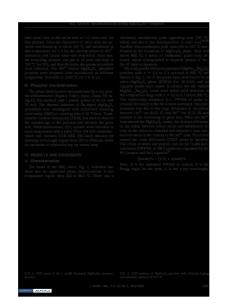Eu 3+ co-doped Sr 3 Gd(PO 4 ) 3 :Dy 3+ phosphors: luminescence properties and color-tunable white-light emission for NUV
- PDF / 3,067,640 Bytes
- 10 Pages / 595.276 x 790.866 pts Page_size
- 104 Downloads / 334 Views
Eu3+ co‑doped Sr3Gd(PO4)3:Dy3+ phosphors: luminescence properties and color‑tunable white‑light emission for NUV‑WLEDs Bin Fan1,2 · Wenyu Zhao2 · Limin Han1 Received: 28 January 2020 / Accepted: 3 March 2020 © Springer-Verlag GmbH Germany, part of Springer Nature 2020
Abstract A series of Dy3+ and Eu3+ co-doped Sr3Gd(PO4)3 phosphors were synthesized by a high-temperature solid-state method. The crystal structure, optical band gap energy, luminescence properties, concentration quenching, energy transfer process and thermal stability were investigated. All the phosphors are pure eulytite-type S r3Gd(PO4)3 in structure. Under different wavelengths’ excitation, the Sr3Gd(PO4)3:Dy3+, Eu3+ phosphors exhibit different emission intensities for Eu3+ and Dy3+. The color and correlated color temperature (CCT) can be tuned from cool white to warm white by adjusting excitation wavelengths and the doping concentration of Eu3+. Under the 351-nm excitation, the optimal Sr3Gd(PO4)3:0.03Dy3+, 0.085Eu3+ phosphor displays a warm white emission with CIE coordinate of (0.3987, 0.3613), CCT of 3409 K, internal quantum efficiency of 44.8% and activation energy of 0.1883 eV. These results suggest that single-phased white-emitting phosphors Sr3Gd(PO4)3:Dy3+, Eu3+ can be used in the near-ultraviolet light-emitting diodes. Keywords Luminescence · Phosphors · Optical materials and properties · Energy transfer
1 Introduction Recently, rare earth ions (REs)-doped single-phased whiteemitting phosphors have become an important research direction to fabricate efficient white near-ultraviolet-pumped light-emitting diodes (NUV-WLEDs), which can have advantages of high efficiency, improved stability, no phase separation, good color reproducibility and low manufacturing cost [1–3]. For doped REs, Dy3+ ion is usually expected to be a potential luminescence center for producing the white-emitting phosphors owing to its two dominant emission bands in the visible region: the blue band (470–500 nm) corresponding to the magnetic dipole 4F9/2 → 6H15/2 transition and the yellow band (570–600 nm) corresponding to the hypersensitive electric dipole 4F 9/2 → 6H 13/2 transition (ΔL = 2, ΔJ = 2) [4, 5]. However, Dy3+ singly doped phosphors have weak red emission, leading to low color * Limin Han [email protected] 1
School of Chemical Engineering, Inner Mongolia University of Technology, Hohhot 010051, China
School of Chemistry and Chemical Engineering, Inner Mongolia University of Science and Technology, Baotou 014010, China
2
rendering index (CRI) and high color temperature. Thus, their usage in many applications is confined [1, 6]. To solve this problem, co-doped Eu3+ is a good choice owing to its characteristic emissions 5D0 → 7FJ (J = 1–4) and the efficient energy transfer from Dy3+ to E u3+. For example, the CIE coordinates of Na3Sc2(PO4)3:Dy3+, Eu3+ phosphors can be tuned from natural white to warm white region and finally to orange pink region with the increasing E u3+ ion concen3+ tration [1]. Dy singly doped CaBi2B2O7
Data Loading...











